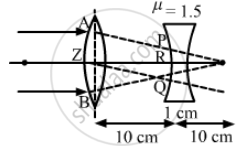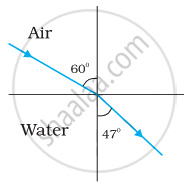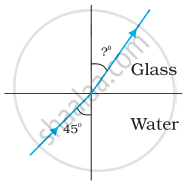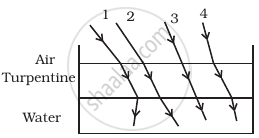Advertisements
Advertisements
Question
A convex lens of focal length 20 cm and a concave lens of focal length 10 cm are placed 10 cm apart with their principal axes coinciding. A beam of light travelling parallel to the principal axis and having a beam diameter 5.0 mm, is incident on the combination. Show that the emergent beam is parallel to the incident one. Find the beam diameter of the emergent beam.
Solution
Given,
Focal length of the convex lens, fd = 20 cm
Focal length of the concave lens, fc = 10 cm
Beam diameter of the incident light, d = 5.0 mm
Distance between both the lenses is 10 cm.
As per the question, the incident beam of light is parallel to the principal axis.
Let it be incident on the convex lens.
Now, let B be the focus of the convex lens where the image by the convex lens should be formed.
For the concave lens,
Object distance (u) = + 10 cm (Virtual object is on the right of concave lens.)
Focal length, fc = − 10 cm
Using the lens formula,
\[\frac{1}{v} - \frac{1}{u} = \frac{1}{f}\]
\[\Rightarrow\frac{1}{v}=\frac{1}{- 10}+\frac{1}{+ 10}=\infty\]
\[\Rightarrow v=\infty\]
Thus, after refraction in the concave lens, the emergent beam becomes parallel.
As shown, in triangles XYB and PQB,
\[\frac{PQ}{XY} = \frac{RB}{ZB} = \frac{10}{20} = \frac{1}{2}\]
\[PQ = \frac{1}{2} \times 5 = 2 . 5 \text{ mm }\]
Thus, the beam diameter of the emergent light is 2.5 mm.
Similarly, we can prove that if the beam of light is incident on the side of the concave lens, the beam diameter (d) of the emergent light will be 1 cm.
APPEARS IN
RELATED QUESTIONS
Light of wavelength 5000 Å propagating in air gets partly reflected from the surface of water. How will the wavelengths and frequencies of the reflected and refracted light be affected?
A tank is filled with water to a height of 12.5 cm. The apparent depth of a needle lying at the bottom of the tank is measured by a microscope to be 9.4 cm. What is the refractive index of water? If water is replaced by a liquid of refractive index 1.63 up to the same height, by what distance would the microscope have to be moved to focus on the needle again?
Figures (a) and (b) show the refraction of a ray in air incident at 60° with the normal to a glass-air and water-air interface, respectively. Predict the angle of refraction in the glass when the angle of incidence in water is 45° with the normal to a water-glass interface [Figure (c)].
 |
 |
 |
| (a) | (b) | (c) |
A small pin fixed on a table top is viewed from above from a distance of 50 cm. By what distance would the pin appear to be raised if it is viewed from the same point through a 15 cm thick glass slab held parallel to the table? Refractive index of glass = 1.5. Does the answer depend on the location of the slab?
Light incident normally on a plane mirror attached to a galvanometer coil retraces backward as shown in Figure. A current in the coil produces a deflection of 3.5° of the mirror. What is the displacement of the reflected spot of light on a screen placed 1.5 m away?

A fish which is at a depth of l2 em .in water `(mu = 4/3)` is viewed by an observer on the bank of a lake. Its apparent depth as observed: by the observer is:
a) 3 cm
b) 9 cm
c) 12 cm
d) 16 cm
For the same value of angle of incidence, the angles of refraction in three media A, B and C are 15°, 25° and 35° respectively. In which medium would the velocity of light be minimum?
A laser light is focussed by a converging lens. Will there be a significant chromatic aberration?
Obtain the equation for apparent depth.
Why do stars twinkle?
What is mirage?
What is looming?
Write a note on optical fibre.
A light travels through water in the beaker. The height of water column is 'h'. Refractive index of water is 'μw'. If c is velocity of light in air, the time taken by light to travel through water will ______.
The critical angle for a ray of light from glass to air is 'θ' and refractive index of glass with respect to air is 'n'. If a ray of light is incident from air to glass at an angle 'θ', then corresponding angle of refraction is ______.
If `"^imu_j` represents refractive index, when a light ray goes from medium i to medium j, then the product `"^2mu_1 xx ^3mu_2 xx ^4mu_3` is equal to ______.
For a rectangular slab, refraction takes place at ______.
The optical density of turpentine is higher than that of water while its mass density is lower. Figure shows a layer of turpentine floating over water in a container. For which one of the four rays incident on turpentine in figure, the path shown is correct?
Three immiscible liquids of densities d1 > d2 > d3 and refractive indices µ1 > µ2 > µ3 are put in a beaker. The height of each liquid column is `h/3`. A dot is made at the bottom of the beaker. For near normal vision, find the apparent depth of the dot.
Using Huygen's wave theory, show that (for refraction of light):
`sin i/sin r = "constant"`
where terms have their usual meaning. You must draw a neat and labelled diagram.
